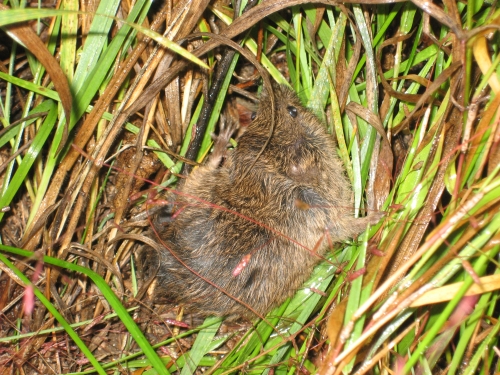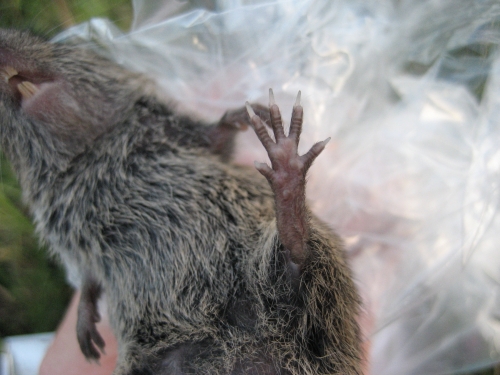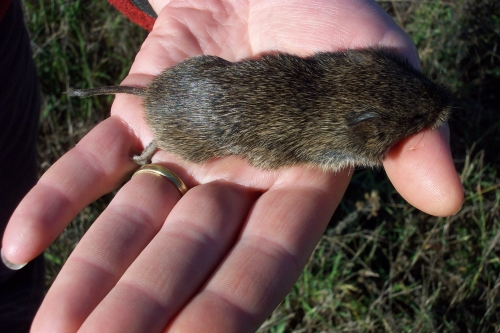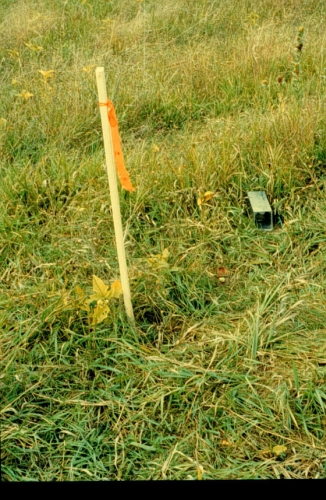Plants and Animals
Microtus ochrogaster Prairie vole
Key Characteristics
The prairie vole is a small mouse-like rodent (4.9 to 6.1 in/12.5 to 15.5 cm) with dark brown fur that has a salt-and-pepper coloration. It can be distinguished from the similar meadow vole by the tan (not gray) belly, 5 (instead of 4) small bumps (i.e., plantar tubercles) on the hind feet, and 3 (rather than 4) pairs of mammary glands.
Status and Rank
US Status: No Status/Not Listed
State Status: E - Endangered (legally protected)
Global Rank: G5 - Secure
State Rank: S3 - Vulnerable
Occurrences
| County | Number of Occurrences | Year Last Observed |
|---|---|---|
| Berrien | 5 | 1962 |
| Cass | 1 | 1933 |
| Kalamazoo | 2 | 2021 |
| Van Buren | 1 | 1960 |
Information is summarized from MNFI's database of rare species and community occurrences. Data may not reflect true distribution since much of the state has not been thoroughly surveyed.
Habitat
The prairie vole occurs in mesic to dry prairies. It is also found in ungrazed pastures, managed rights-of-way, old field borders, fallow fields, hay fields, and alfalfa and soybean fields. It prefers drier habitats than the meadow vole, but populations are lower in short, sparse grass than in tall, lush vegetation growth. They prefer a thick ground cover of herbaceous vegetation.
Natural Community Types
For each species, lists of natural communities were derived from review of the nearly 6,500 element occurrences in the MNFI database, in addition to herbarium label data for some taxa. In most cases, at least one specimen record exists for each listed natural community. For certain taxa, especially poorly collected or extirpated species of prairie and savanna habitats, natural community lists were derived from inferences from collection sites and habitat preferences in immediately adjacent states (particularly Indiana and Illinois). Natural communities are not listed for those species documented only from altered or ruderal habitats in Michigan, especially for taxa that occur in a variety of habitats outside of the state.
Natural communities are not listed in order of frequency of occurrence, but are rather derived from the full set of natural communities, organized by Ecological Group. In many cases, the general habitat descriptions should provide greater clarity and direction to the surveyor. In future versions of the Rare Species Explorer, we hope to incorporate natural community fidelity ranks for each taxon.
Management Recommendations
Prairie, savanna, and other grassy habitats, as well as grassy corridors between grassy habitats should be maintained. Frequent mowing should be avoided. Any lack of cover can be detrimental to vole populations. Limiting factors for the species include intensive land-use patterns such as conversion to row crops and overuse of pesticides. An increase in non-native predator species (e.g., domestic cat) and densities has been associated with high rodent mortality. Grazing by large domesticated herbivores in tallgrass communities and possible displacement by other more common rodents such as meadow voles also may lead to declines in prairie vole populations.
Active Period
Breeding from first week of February to first week of November
Survey Methods
Prairie voles are most active just before dawn and from sunset until dark. Populations are strongly cyclical with peak densities occurring every 2 to 4 years, and as much as a 90% difference in population between peak years, so surveys in multiple consecutive years are recommended to adequately assess presence/absence and average population density. The voles make use of surface runways (1.4-3.5 in/3.5-8.9 cm in diameter) formed through the base of vegetation. Runways are the most conspicuous sign of vole presence; mole tunnels may also be used by the vole.
Live trap along surface runways
Survey Period: From first week of April to fourth week of October
Time of Day: Morning (sunrise)
Time of Day: Evening
References
Survey References
- Baker, R.H. 1983. Michigan Mammals. Michigan State University Press, East Lansing.
- Wilson, D.E., F.R. Cole, J.D. 1996. Measuring and Monitoring Biological Diversity - Standard Methods for Mammals. Smithsonian Institution Press, Washington D.C.
Technical References
- Baker, R.H. 1983. Michigan Mammals. Michigan State University Press, East Lansing.
- Evers, D.C. 1994. Endangered and Threatened Wildlife of Michigan. The University of Michigan Press, Ann Arbor. 412pp.
- Kurta, A. 1995. Mammals of the Great Lakes Region. The University of Michigan Press, Ann Arbor.








